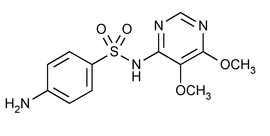Sulfadoxine
(sul'' fa dox' een).
Benzenesulfonamide, 4-amino-N-(5,6-dimethoxy-4-pyrimidinyl)-.
N1-(5,6-Dimethoxy-4-pyrimidinyl)sulfanilamide
» Sulfadoxine contains not less than 99.0 percent and not more than 101.0 percent of C12H14N4O4S, calculated on the dried basis.
Sulfadoxine contains not less than 99.0 percent and not more than 101.0 percent of C12H14N4O4S, calculated on the dried basis.
Packaging and storage—
Preserve in well-closed, light-resistant containers.
Identification—
Solution:
6 µg per mL.
Medium:
0.1 N sodium hydroxide.
C:
The retention time of the major peak in the chromatogram of the Assay preparation corresponds to that in the chromatogram of the Standard preparation, as obtained in the Assay.
Melting range  741
741 :
between 197
:
between 197 and 200
and 200 .
.
Loss on drying  731
731 —
Dry it at 105
—
Dry it at 105 for 4 hours: it loses not more than 0.5% of its weight.
for 4 hours: it loses not more than 0.5% of its weight.
Residue on ignition  281
281 :
not more than 0.1%.
:
not more than 0.1%.
Heavy metals, Method II  231
231 :
0.002%.
:
0.002%.
Chromatographic purity—
Prepare a solution in a mixture of alcohol and ammonium hydroxide (9:1) having a concentration of about 20 mg per mL. Prepare a Standard solution of USP Sulfadoxine RS having a concentration of about 0.10 mg per mL in a mixture of alcohol and ammonium hydroxide (9:1). Separately apply 10 µL each of the test solution and the Standard solution to a suitable chromatographic plate (see Chromatography  621
621 ) coated with a 0.25-mm layer of chromatographic silica gel. Develop the chromatogram in a solvent system consisting of a mixture of chloroform, methanol, and dimethylformamide (20:2:1) until the solvent front has moved about three-fourths of the length of the plate. Remove the plate from the chamber, and air-dry. Spray the dried plate with a 1 in 10 solution of sulfuric acid in alcohol, and expose to nitrous fumes generated by adding 7 M sulfuric acid dropwise to a solution containing 10% sodium nitrite and 3% potassium iodide. Dry the plate in a current of warm air for 15 minutes, and spray with a 1 in 200 solution of N-(1-naphthyl)ethylenediamine dihydrochloride in alcohol. No spot in the test solution, other than the principal spot, is greater in size and intensity than the spot obtained from the Standard solution.
) coated with a 0.25-mm layer of chromatographic silica gel. Develop the chromatogram in a solvent system consisting of a mixture of chloroform, methanol, and dimethylformamide (20:2:1) until the solvent front has moved about three-fourths of the length of the plate. Remove the plate from the chamber, and air-dry. Spray the dried plate with a 1 in 10 solution of sulfuric acid in alcohol, and expose to nitrous fumes generated by adding 7 M sulfuric acid dropwise to a solution containing 10% sodium nitrite and 3% potassium iodide. Dry the plate in a current of warm air for 15 minutes, and spray with a 1 in 200 solution of N-(1-naphthyl)ethylenediamine dihydrochloride in alcohol. No spot in the test solution, other than the principal spot, is greater in size and intensity than the spot obtained from the Standard solution.
Assay—
0.1% Phosphoric acid solution—
Add 1 mL of phosphoric acid to water, and dilute to 1000 mL.
Mobile phase—
Prepare a suitable degassed and filtered mixture of 0.1% Phosphoric acid solution and acetonitrile (83:17). Make adjustments if necessary (see System Suitability under Chromatography  621
621 .
.
Standard preparation—
Transfer an accurately weighed quantity of USP Sulfadoxine RS to a suitable volumetric flask, dissolve first with acetonitrile using about 17% of the final volume, then dilute with 0.1% Phosphoric acid solution to volume and mix to obtain a solution having a known concentration of about 0.4 mg of sulfadoxine per mL.
Assay preparation—
Transfer an accurately weighed quantity of Sulfadoxine to a suitable volumetric flask, dissolve first with acetonitrile using about 17% of the final volume, then dilute with 0.1% Phosphoric acid solution to volume and mix to obtain a solution having a concentration of about 0.4 mg of sulfadoxine per mL.
Chromatographic system (see Chromatography  621
621 )—
The liquid chromatograph is equipped with a 230-nm detector and a 2.0-mm × 10-cm column that contains 3-µm packing L11. The flow rate is about 0.3 mL per minute. Chromatograph replicate injections of the Standard preparation, and record the peak responses as directed for Procedure: the tailing factor is not more than 1.8; and the relative standard deviation for replicate injections is not more than 1.0%.
)—
The liquid chromatograph is equipped with a 230-nm detector and a 2.0-mm × 10-cm column that contains 3-µm packing L11. The flow rate is about 0.3 mL per minute. Chromatograph replicate injections of the Standard preparation, and record the peak responses as directed for Procedure: the tailing factor is not more than 1.8; and the relative standard deviation for replicate injections is not more than 1.0%.
Procedure—
Separately inject equal volumes (about 5 µL) of the Standard preparation and the Assay preparation into the chromatograph, record the chromatograms, and measure the responses for the major peaks. Calculate the percentage of C12H14N4O4S in the portion of Sulfadoxine taken by the formula:
100(CS / CU)(rU / rS)
in which 100 is the percent conversion factor; CS is the concentration, in mg per mL, of USP Sulfadoxine RS in the Standard preparation; CU is the concentration, in mg per mL, of Sulfadoxine in the Assay preparation; and rU and rS are the peak responses obtained from the Assay preparation and the Standard preparation, respectively.
Auxiliary Information—
Please check for your question in the FAQs before contacting USP.
| Topic/Question | Contact | Expert Committee |
|---|---|---|
| Monograph | Leonel M. Santos, Ph.D.
Senior Scientific Liaison 1-301-816-8168 |
(SM12010) Monographs - Small Molecules 1 |
| Reference Standards | RS Technical Services 1-301-816-8129 rstech@usp.org |
USP35–NF30 Page 4712
Pharmacopeial Forum: Volume No. 34(2) Page 300

